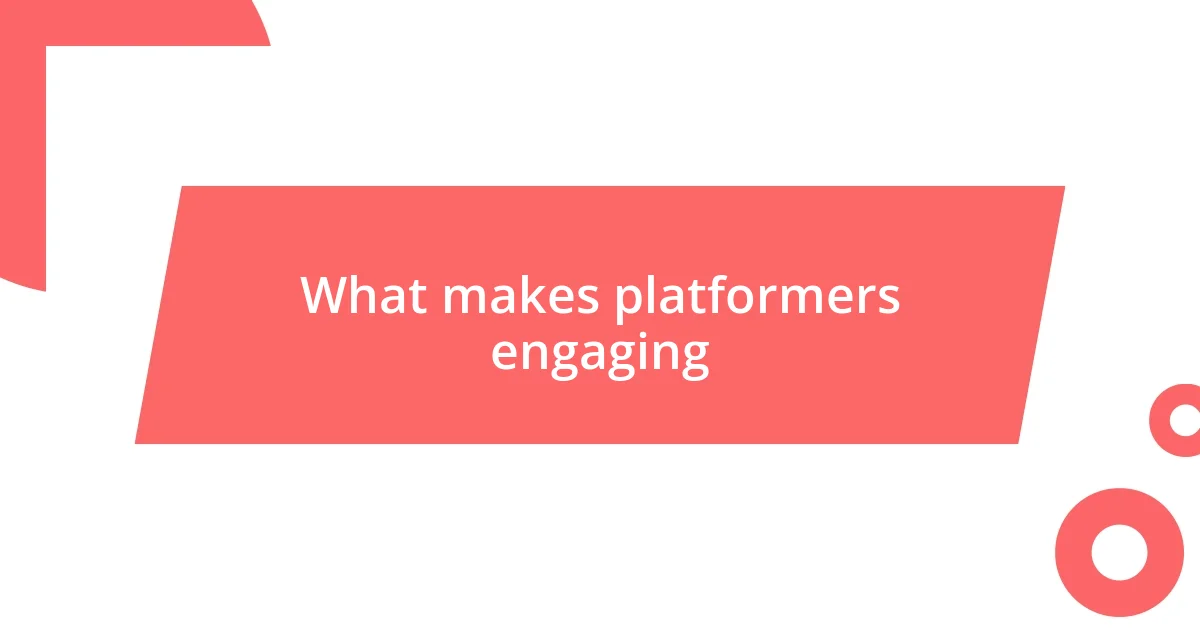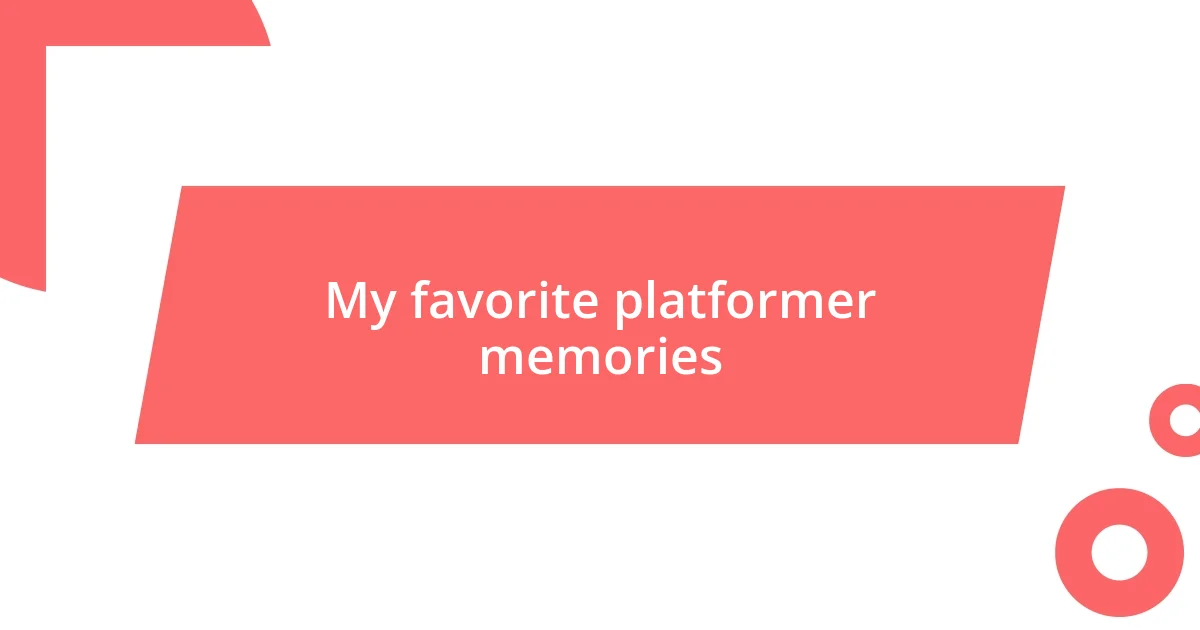Key takeaways:
- The author’s first platforming experience with “Super Mario Bros.” ignited a passion for the genre, highlighting the emotional connection and resilience developed through gameplay.
- Classic platformers like “Sonic the Hedgehog” fostered camaraderie and excitement, creating cherished memories during late-night gaming sessions with friends.
- Modern innovations in platformers, including unique mechanics and co-op gameplay, enhance the gaming experience, while diverse art styles evoke deep emotional responses.

My first platforming experience
I still remember the moment my hands first gripped the controller, heart racing as I leapt into the colorful world of “Super Mario Bros.”. The thrill of dodging Goombas and jumping over pits was electrifying. Can you recall that feeling when you clear your first difficult level? It felt like conquering my own little mountain.
As I navigated the pixelated platforms, I discovered that each jump felt like a dance, rhythmic and exhilarating. There were times I faced frustrating falls and setbacks, yet with every retry, I learned to time my jumps better. Those moments taught me resilience in a playful way, which surprisingly mirrored challenges I encountered in real life.
One night, I stayed up well past my bedtime, engrossed in chasing after that elusive flagpole at the end of the level. The excitement was palpable, and I could hardly contain my cheers whenever I succeeded. Isn’t it incredible how a simple platformer can evoke such a rush of emotions, creating a timeless bond between player and game?

Discovering classic platformers
My journey into classic platformers began a bit later, yet it was no less captivating. I stumbled upon “Sonic the Hedgehog,” and I was instantly drawn to the fast-paced gameplay and vibrant colors. I remember zipping through Green Hill Zone, feeling like I was flying. The rush of collecting rings while evading pesky enemies was exhilarating, like a high-speed chase.
- The world felt alive, with loops and springs beckoning me to explore.
- Each unique level introduced fresh challenges, making every playthrough feel dynamic.
- I often invited friends over for “Sonic” marathons, where laughter and competition filled the room.
- My finger muscles ached from all the frantic button mashing, but it was worth it for that adrenaline rush.
Even now, I fondly recall those late-night gaming sessions, filled with excitement and a sense of camaraderie. These early experiences not only honed my gaming skills but also created bittersweet memories that I cherish. It truly cemented my love for the platforming genre.

Understanding platformer game mechanics
Understanding platformer game mechanics can be a journey, much like the games themselves. One key aspect that draws players in is the core mechanics centered around jumping and movement. I still remember the satisfaction of mastering the timing of my jumps in “Celeste,” where each leap felt like a personal achievement. The nuanced control over height and distance truly transformed my approach to each level, giving me a sense of mastery that was hard to replicate in other genres.
Another interesting element is the level design, which often incorporates verticality and hidden paths. I was once mesmerized by the beautifully designed levels in “Rayman Legends,” where every corner held a potential secret. As I explored, I experienced a rush of discovery that made me want to return to prior levels. This interconnectedness and sense of adventure solidified my appreciation for the genre and kept me eagerly returning for more.
Finally, the challenge provided by platformers is a crucial element of their appeal. I fondly recall the thrill of perseverance required in “Super Meat Boy,” where every hit felt brutal, yet rewarding progress was always just one more retry away. It taught me that failure can be part of the fun, and often, pushing through those challenging moments truly enriched the experience.
| Game Mechanics | Description |
|---|---|
| Jumping & Movement | Detailed control of jumps gives players a sense of mastery. |
| Level Design | Verticality and hidden paths enhance exploration and discovery. |
| Challenge & Perseverance | Emphasizes that failure is part of the fun, rewarding persistence. |

What makes platformers engaging
Engagement in platformers often stems from the satisfying rhythm of jumping and navigating obstacles. I can recall countless moments when my heart raced as I timed a leap just right, landing perfectly on a moving platform. That instant where everything feels aligned, as if I’m dancing through the game, is what keeps me coming back for more.
The art of exploration in platformers is truly captivating. I vividly remember discovering secret areas in “Ori and the Blind Forest.” It wasn’t just about completing levels but uncovering hidden treasures that made me feel like a true adventurer. Every nook and cranny held a surprise, and the thrill of exploration added layers of excitement that I didn’t want to end.
Then there’s the aspect of narrative and character connection. When I played “Hollow Knight,” I found myself emotionally invested in the little knight’s journey. I often pondered, what drives this tiny hero? As I faced challenges and setbacks, I felt a kinship with the character, which deepened my experience. These connections elevate platformers from mere games to heartfelt journeys.

Exploring modern platformer innovations
Diving into the world of modern platformers, I can’t help but appreciate how developers are pushing the boundaries of design. For instance, when I played “A Hat in Time,” I was struck by how the game introduced a time-bending mechanic that let me manipulate the environment in ways I hadn’t experienced before. It made me wonder, how many more creative twists and turns can a platformer incorporate while remaining true to its roots?
Additionally, the integration of co-op gameplay has transformed the platforming scene. I recall my laughter-filled evenings with friends while playing “Unravel Two,” where teamwork was crucial to maneuver through intricately designed levels. This shared experience not only deepened my love for platformers but also reminded me of the joy of connecting with others in a digital realm.
Moreover, the art styles in contemporary platformers have become increasingly diverse and visually striking. I was particularly mesmerized by the vibrant, hand-drawn aesthetics of “Cuphead.” It’s fascinating how such a unique visual approach can redefine one’s gaming experience and evoke emotions that draw you deeper into the game world. Isn’t it amazing how artistry can intertwine with gameplay to create an experience that feels both nostalgic and refreshingly new?

Tips for getting started
Getting started with platformers can be a delightful experience if you approach it with the right mindset. I remember my first time diving into “Super Mario Odyssey,” where the world felt so vast and inviting. My advice? Don’t rush! Take your time to absorb the environment. You’ll find that each level is not just a series of jumps; it’s a beautifully crafted space filled with secrets just waiting to be discovered.
As you begin, consider experimenting with different titles to see which gameplay style resonates with you. For example, I didn’t gel with the quicker-paced, frantic nature of “Celeste” right away, but after giving it a real chance, I found the story and emotional depth compelling. Have you ever played a game that surprised you? Sometimes, it takes a few attempts to unlock the magic of a platformer.
Lastly, engage with the community. I often jump into forums or watch playthroughs on platforms like Twitch. Sharing experiences and strategies with fellow gamers has enriched my understanding and appreciation of the genre. Plus, you’ll find others who share that same rush of joy when they nail a tough jump or uncover a hidden treasure. What’s better than connecting with others who share your passion?

My favorite platformer memories
Reflecting on my platformer journey, I can’t help but smile when I think about “Rayman Legends.” The musical levels, packed with rhythm and creativity, turned into sessions filled with spontaneous dancing and laughter. I remember one night, my friends and I were so engrossed that we lost track of time, which made the achievement of finishing a challenging level feel even more rewarding. Isn’t it incredible how a game can make time slip away like that?
One of my fondest memories was playing “Ori and the Blind Forest” for the first time. The emotional storytelling combined with the stunning visuals stirred something deep within me. There’s a particular scene where Ori is navigating through a heart-wrenching scenario, and I felt my heart racing, completely invested in the journey. Have you ever felt that level of connection with a game? It’s moments like these that remind me of the profound impact platformers can have on us.
Then, there was the nostalgic thrill of speedrunning through “Sonic the Hedgehog” with my siblings. I can still hear their cheers as I finally beat my personal record, the satisfaction of mastering each level together brought us closer. I often think about how those competitive moments, filled with friendly rivalry and support, lit a fire in my passion for platformers. Isn’t it amazing how these shared experiences become treasures we carry with us long after the game is over?















